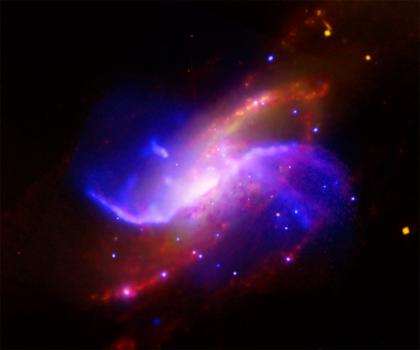For Release: April 10, 2007
Univ. of MD/GSFC Release
Using a quartet of space observatories, University of Maryland astronomers may have cracked a 45-year mystery surrounding two ghostly spiral arms in the galaxy M106.
The Maryland team, led by Yuxuan Yang, took advantage of the unique capabilities of NASA's Chandra X-ray Observatory, NASA's Spitzer Space Telescope, the European Space Agency's XMM-Newton X-ray observatory, and data obtained almost a decade ago with NASA's Hubble Space Telescope.
M106 (also known as NGC 4258) is a stately spiral galaxy 23.5 million light-years away in the constellation Canes Venatici. In visible-light images, two prominent arms emanate from the bright nucleus and spiral outward. These arms are dominated by young, bright stars, which light up the gas within the arms. "But in radio and X-ray images, two additional spiral arms dominate the picture, appearing as ghostly apparitions between the main arms," says team member Andrew Wilson of the University of Maryland. These so-called "anomalous arms" consist mostly of gas.
"The nature of these anomalous arms is a long-standing puzzle in astronomy," says Yang. "They have been a mystery since they were first discovered in the early 1960s."
By analyzing data from XMM-Newton, Spitzer, and Chandra, Yang, Bo Li, Wilson, and Christopher Reynolds, all at the University of Maryland at College Park, have confirmed earlier suspicions that the ghostly arms represent regions of gas that are being violently heated by shock waves.
Previously, some astronomers had suggested that the anomalous arms are jets of particles being ejected by a supermassive black hole in M106's nucleus. But radio observations by the National Radio Astronomy Observatory's Very Long Baseline Array, and the Very Large Array in New Mexico, later identified another pair of jets originating in the core. "It is highly unlikely that an active galactic nucleus could have more than one pair of jets," says Yang.
In 2001, Wilson, Yang, and Gerald Cecil, of the University of North Carolina, Chapel Hill, noted that the two jets are tipped 30 degrees with respect to the galaxy disk. But if one could vertically project the jets onto the disk, they would line up almost perfectly with the anomalous arms. Figuring that this alignment was not strictly a matter of chance, Wilson, Yang, and Cecil proposed that the jets heat the gas in their line of travel, forming an expanding cocoon. Because the jets lie close to M106's disk, the cocoon heats gas in the disk and generates shock waves, heating the gas to millions of degrees and causing it to radiate brightly in X-rays and other wavelengths.
To test this idea, Yang and his colleagues looked at archival spectral observations from XMM-Newton. With XMM-Newton's superb sensitivity, the team could measure the gas temperature in the anomalous arms and also see how strongly X-rays from the gas are absorbed en route by intervening material.
"One of the predictions of this scenario is that the anomalous arms will gradually be pushed out of the galactic disk plane by jet-heated gas," says Yang. The XMM-Newton spectra show that X-rays are more strongly absorbed in the direction of the northwest arm than in the southeast arm. The results strongly suggest that the southeast arm is partly on the near side of M106's disk, and the northwest arm is partly on the far side.
The scientists noted that these observations show clear consistency with their scenario. Confirmation of this interpretation has recently come from archival observations from NASA's Spitzer Space Telescope, whose infrared view shows clear signs that X-ray emission from the northwest arm is being absorbed by warm gas and dust in the galaxy's disk. Moreover, Chandra's superior imaging resolution gives clear indications of gas shocked by interactions with the two jets.
Besides addressing the mystery of the anomalous arms, these observations allowed the team to estimate the energy in the jets and gauge their relationship to M106's central black hole. The team's paper will appear in the May 10 issue of the Astrophysical Journal.
http://www.nasa.gov/centers/goddard/news/topstory/2007/mystery_spiralarms.html
For more information about XMM-Newton X-ray observatory, visit:
http://xmm.vilspa.esa.es/
For more information about NASA's Chandra X-ray Observatory, visit:
http://chandra.harvard.edu/
For more information about NASA's Spitzer Space Telescope, visit:
http://www.spitzer.caltech.edu/
For more information about the Very Large Array, visit:
http://www.vla.nrao.edu/





